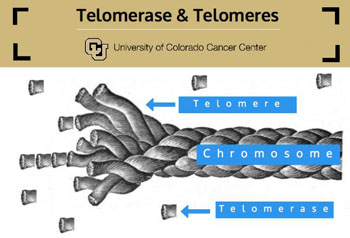Single Molecule Imaging Reveals How Telomerase Finds and Binds to the Telomere
By LabMedica International staff writers
Posted on 31 Aug 2016
Genomics researchers have combined the CRISPR/Cas9 gene editing technique with advanced single-molecule imaging technology to demonstrate how the enzyme telomerase finds and attaches to the telomere, the region of repetitive nucleotide sequences at each end of a chromosome, which protects the end of the chromosome from deterioration or from fusion with neighboring chromosomes.Posted on 31 Aug 2016
Telomerase maintains genome integrity by adding repetitive DNA sequences to the chromosome ends in actively dividing cells, including 90% of all cancer cells. Recruitment of human telomerase to telomeres occurs during S-phase of the cell cycle, but the molecular mechanism of the process is only partially understood.

Image: Protective telomeres are augmented by freely diffusing telomerase (Photo courtesy of University of Colorado Cancer Center).
To examine this mechanism, investigators at the University of Colorado Cancer Center (Denver) used the CRISPR/Cas9 gene editing technique to insert the gene for a fluorescent protein marker into the telomerase gene, which resulted in telomerase proteins that could be observed under a fluorescent microscope. The marked telomerase molecules were tracked with a single-molecule imaging system in the nuclei of living human cells.
The investigators reported in the August 11, 2016, online edition of the journal Cell that telomerase used three-dimensional diffusion to search for telomeres, probing each telomere thousands of times each S-phase but only rarely forming a stable association. Both the transient and stable association events depended on the direct interaction of the telomerase protein TERT (Telomerase reverse transcriptase) with the telomeric protein TPP1. When telomerase found and attached to a telomere, it added a repeating DNA sequence to the repeating DNA sequences that were already in place, lengthening the telomere and adding to the chromosome's protective ends.
"Right now we do not have a great telomerase inhibitor. We do not know at which step our first generation of these drugs is interfering so we do not know how to optimize these drug candidates for anti-cancer effect," said senior author Dr. Thomas Cech, Nobel Prize winning professor of chemistry and biochemistry at the University of Colorado. "Does a drug prevent the assembly of telomerase? Does it keep telomerase from moving near telomeres? Does it prevent telomerase from finding a telomere end? Knowing where a drug blocks the ability of telomerase to lengthen telomeres could have broad applicability for diverse cancers."
Related Links:
University of Colorado Cancer Center














